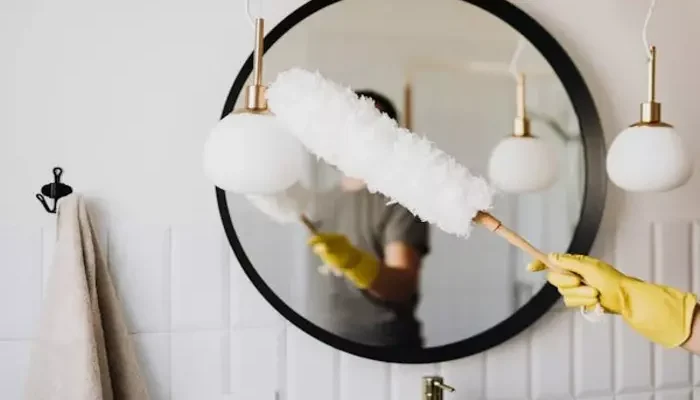Your home may sparkle on the surface, but germ hotspots hide in plain sight. These often neglected areas, easily overlooked during routine cleaning, can become thriving breeding grounds for bacteria and germs. From your kitchen sink to your pet’s bowl, these everyday objects contain surprising contamination levels.
Understanding and addressing these hotspots is critical to maintaining a clean and healthy living environment.
This blog post uncovers these often-forgotten areas, reveals their potential health risks, and provides practical tips to keep your home sparkling and safe.
The Overlooked Hotspots and Their Associated Risks
Let’s examine these germ hotspots in your home and the potential health risks they pose.
Kitchen Sink
The kitchen sink, where you wash dishes and prepare food, often harbors more bacteria than your toilet bowl. Shocking, isn’t it? According to a study, the kitchen sink drain is the most positive location for foodborne bacteria contamination.
Combining food particles, moisture, and warmth creates a perfect breeding ground for bacteria. Raw meat juices, unwashed vegetables, and even leftover food scraps get into your sink, creating a microbial buffet that can lead to serious health risks, including foodborne illnesses and cross-contamination.
Cutting Boards
Your cutting board, a kitchen essential for meal prep, might hide a dirty secret. HealthymePA highlights that University of Arizona researchers say cutting boards can harbor up to 200 times more fecal bacteria than a toilet seat. It’s an unsettling thought, but understanding its reasons can help you take the necessary precautions.
The culprit lies in your knives’ seemingly harmless grooves and scratches. These tiny crevices create the perfect hiding spots for food particles and bacteria. Raw meat, especially poultry, is a common carrier of harmful bacteria like E. coli, Salmonella, and Campylobacter. When these juices seep into the cutting board’s surface, they pose a potential hazard for cross-contamination.
Bathroom
Your bathroom may have more germs than you’d expect. According to SafeHome.org, your bathroom curtains and floor could have 60 times more bacteria than your toilet seat. This surprising statistic highlights the importance of paying closer attention to these frequently touched surfaces.
Often placed near the sink, toothbrush holders are susceptible to germ buildup. They can accumulate moisture and toothpaste residue, providing a cozy home for bacteria to multiply.
These overlooked germ hotspots can contribute to the spread of illness. Touching a contaminated curtain or toothbrush holder and then touching your face, eyes, or mouth can introduce harmful bacteria into your system, potentially leading to infections.
Refrigerator Handles & Door Seals
We often reach for the refrigerator handle multiple times daily, grabbing a snack, a drink, or ingredients for a meal. But did you know these seemingly innocuous handles can harbor a surprising amount of grime?
The reason is frequent touching. We interact with refrigerator handles with unwashed hands, transferring germs and bacteria from our daily activities. Additionally, spills and drips can accumulate in the crevices of the door seals, creating a moist environment where mold and bacteria thrive.
Pet Bowls & Toys
We love our furry companions and want to give them the best, but even their bowls and toys can have hidden dangers. A study found that metal dog food bowls harbor bacterial contamination when used with wet food.
These bacteria thrive in the moist environment created by leftover food and saliva. Pet toys, especially those frequently chewed or left on the floor, can also accumulate bacteria and become a source of contamination.
Tips for Effective Cleaning and Maintenance
Consistency is vital in the battle against household germs. Establishing a routine cleaning schedule prioritizes high-touch areas and those prone to moisture and food debris. Using the right cleaning products and methods for each area is important.
Always follow cleaning product instructions, ensuring proper dilution and contact time for effective disinfection. Microfiber cloths are excellent for capturing dirt and bacteria. Remember to clean or replace cleaning tools themselves regularly.
Here are some preventive measures to apply:
- Handwashing: This simple act is the first line of defense against germs. Encourage frequent handwashing with soap and water, especially before and after handling food, using the bathroom, or touching pets.
- Avoid cross-contamination: In the kitchen, use separate cutting boards for raw meat and produce. Always wash hands and surfaces thoroughly after handling raw foods.
- Keep pet areas clean: Our pets bring us joy but can also carry germs. Clean food and water bowls regularly, wash toys and scoop litter boxes daily. Scoop Soldiers stress using biodegradable and non-toxic cleaning agents that wash microbes from floors and carpets, ensuring pet safety. You can also consult veterinarians to choose the safest option.
For dogs, maintaining a clean yard is essential for aesthetics and hygiene. Consider using a dog poop pickup service for your outdoor space to remain free from bacteria that can be present in dog waste. This helps protect your family, especially young children who love playing outdoors, and keeps your lawn looking its best.
- Regularly clean and replace sponges & dishcloths: These kitchen workhorses can harbor shocking bacteria. Sanitize sponges periodically and replace them frequently. Opt for machine-washable dishcloths and launder them often.
- Consider professional cleaning for showerheads and washing machines: These appliances can develop hard-to-reach biofilm and mold, impacting their performance and potentially posing health risks. Periodic professional cleaning ensures they remain hygienic and efficient.
FAQs
What are the most common household bacteria?
Staphylococcus is the most common household bacteria, often found on skin and surfaces. Micrococcus, Bacillus, and Pseudomonas are also found in soil and water and sometimes in food spoilage. While most are harmless, some strains can cause illness, highlighting the importance of good hygiene.
What household items have the most bacteria?
Kitchen sponges and dishcloths are notorious for harboring the most bacteria in households. Their dampness and frequent contact with food debris create an ideal breeding ground for microbes. Other germ hotspots include kitchen sinks, cutting boards, refrigerator handles, and even your toothbrush holder.
Where in the house are there the most germs?
The kitchen is a hotbed for bacteria, with dishcloths, sponges, and sinks harboring high levels. Frequently touched surfaces like doorknobs, light switches, and appliance handles also accumulate germs. Bathrooms, particularly the toilet area and shower, are prone to bacteria growth due to moisture. Finally, pet areas like food bowls and toys can also be significant sources of bacteria.
Your home is your sanctuary; taking proactive steps to keep it clean and hygienic is an investment in your well-being. You can significantly reduce the risk of illness by tackling those often-neglected hotspots and incorporating mindful cleaning practices into your routine.
So, roll up your sleeves, grab your cleaning supplies, and transform your home into a haven of health and hygiene today.
Choice Home Warranty George Foreman in 2024










Comments